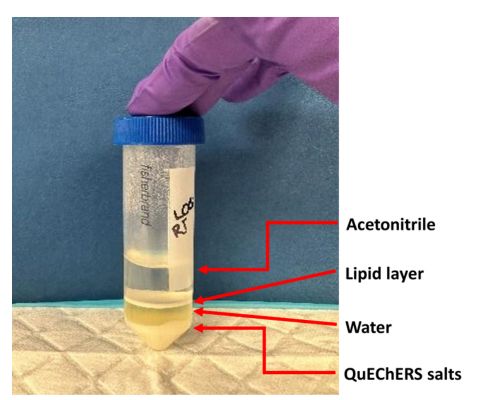In this fourth and final part of the series, Smithers Study Director, Sidney Bluemink, discusses some of the more specialized QuEChERS methods including QuPPe (Quick Polar Pesticides) and QuOil.
QuPPe (Quick Polar Pesticides)
As already discussed, QuEChERS is not especially effective for the analysis of polar pesticides. The Mega-Method addresses this issue to an extent, but QuPPe goes even further for highly polar pesticides such as paraquat, diquat and perchlorate. Additionally, these compounds are problematic to analyze by reverse phase chromatography and may require ion chromatography (IC) or hydrophilic interaction chromatography (HILIC) (1).

Salting out is replaced by freeze-precipitation to remove lipids, sugars and proteins (with pre-heating, if necessary, to melt and separate fats). These matrix components are then removed by centrifugation, performed in a refrigerated centrifuge, while retaining the polar pesticides in the acidified methanol. Due to the simplicity of the method, matrix effects are more likely to be encountered, and so this method can often rely on isotopically labelled internal standards (IL-IS) being introduced at the beginning of the method in order to compensate for matrix effects. This also has the benefit of addressing volume deviations resulting from the varying water content present in samples and the volume adjustment step, and in addressing analyte loss through binding to vessels. Where internal standard is not available, quantification by standard addition is likely to be required to achieve acceptable accuracy and repeatability.
Due to the relevant recency of QuPPe, the literature database is still small in comparison with QuEChERS publications. What appears to be an accompanying development with QuPPe methodology is the employment of accurate mass spectrometry detectors such as quadrupole time of flight (Q-TOF) and Orbitrap MS.
QuOil methodology also deserves a mention here. As the name suggests this modified procedure is used to extract oily samples, especially seeds such as rapeseed, sesame seeds and poppy seeds. Sample proportions are usually scaled down, the initial “salting out” step is skipped, and the acetonitrile extract is mixed with water and subjected to direct dSPE using high amounts of C18 sorbent to absorb the lipids. Conventional QuEChERS can still be used for oily samples, but it is likely a tertiary middle lipid layer will form between the aqueous and organic layer. If the analyte is lipophilic, then losses could occur with underestimation of the levels present. An effect that would quickly manifest itself when analyzing quality control samples.
 Conclusion
Conclusion
QuEChERS, and its derivatives and its iterations, are already in widespread use in the food monitoring industry. Its application in environmental testing for the development of pesticides, chemical and pharmaceuticals studies has been more limited, mainly due to the scale (sample number) of the studies involved in GLP testing of new compounds and those undergoing testing for registration renewal or extension. Smithers uses QuEChERS as part of the analytical toolkit available and for all study types, with the knowledge that its use should always be an option in the arsenal of analytical extraction techniques. While it is often the economic benefits that are discussed when it comes to QuEChERS, the benefits also translate to better quality and reproducible science.
Part 1 in this series covered the wide-raging application of QuEChERS and its variants.
Part 2 in this series discusses the method and application of QuEChERS.
Part 3 in this series discusses the varied application of QuEChERSER.
.jpg)
A
uthor:
Sidney Bluemink
Study Director
Harrogate, UK
Reference
1. Home of the QuPPe Method (www.quppe.eu)



.jpg) Author:
Author: